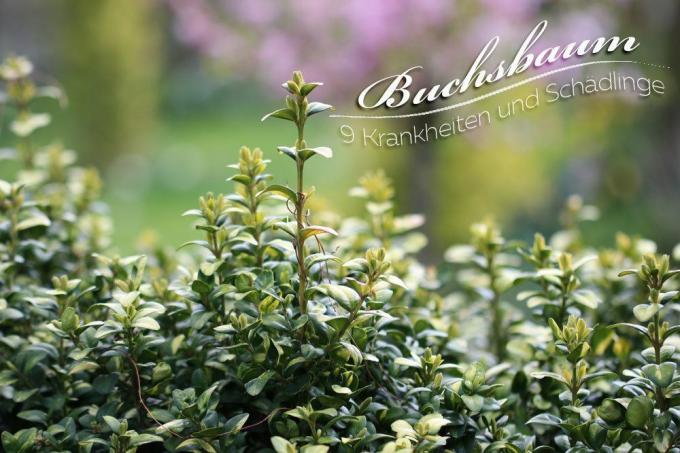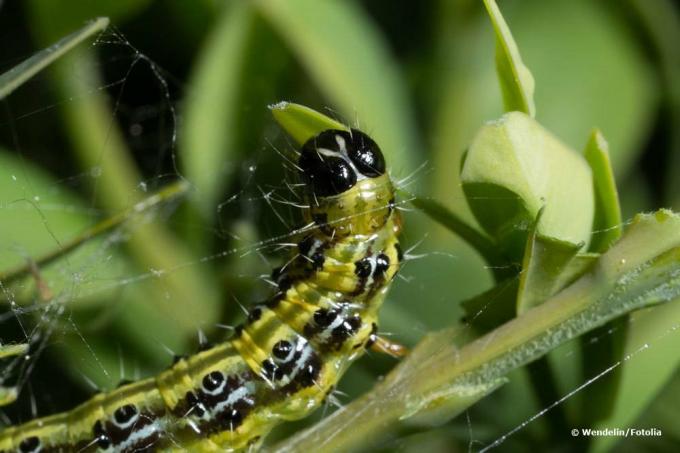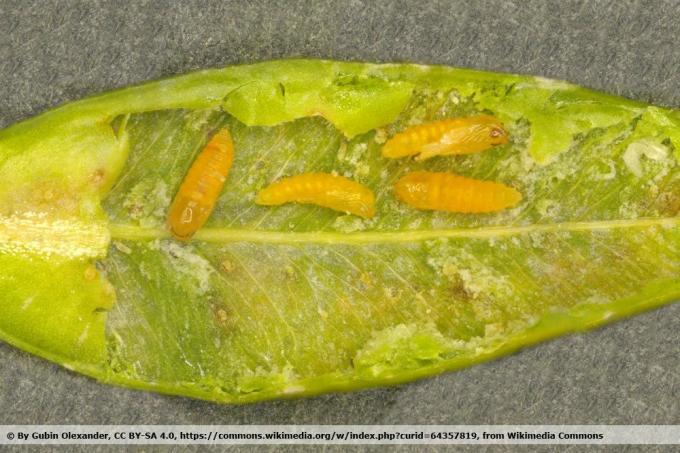
table of contents
- Boxwood diseases
- Boxwood shoot deaths
- Sooty fungus
- Boxwood shrimp
- Boxwood wilt
- Boxwood rust
- recurring methods by similar pathogens
- Pests on the boxwood
- Box tree moth
- Boxwood leaf flea
- Boxwood spider mite
- Boxwood gnat
Whether stringently designed hedge or solitary planting in free form, the box tree, or also Buxus sempervirens, enjoys great variety due to its great variety of designs Popularity. The disappointment is all the greater when pests and diseases ruin the painstakingly created and cared-for look. Knowing about the most well-known diseases and pests helps you to classify the damage pattern found and to take the necessary countermeasures.
Boxwood diseases
Hardly any other plant is seen as often in the gardens as the boxwood. Whether as a hedge or a solitary plant - it offers endless design options. It is all the more sad when Buxus sempervirens is attacked by diseases. Below you will find an overview of the most common diseases on boxwood.
Recurring diseases from Buxus sempervirens
Boxwood shoot deaths
(Cylindrocladium buxicola)

Identifying features
- larger, dark brown spots on leaves
- At the same time, white spore beds are formed on the undersides of the leaves
- black vertical stripes on the shoots
Pathogen
- host-specific fungus
- favored by warm, humid weather in summer
episode
- strong leaf fall
- then death of the shoots
measures
- Control with fungicidal agents
- Prevention through a sunny yet airy location for quick drying after rainfall
- However, water only in the root area and not over the leaves in order to avoid fungal moisture on the leaves
Sooty fungus
(Capnodiales)
Identifying features
- gray-black, flat coating on the upper sides of the leaves
Pathogen
- different mushrooms
follow
- Reduction of metabolism and photosynthetic output of Buxus sempervirens
- In the long run, the plant will be weakened significantly
measures
- Use of approved fungicides
- in the case of intensive infestation, remove infested parts of the plant, as fungal spores overwinter in dead leaves
- Regularly remove and remove dead leaves
Boxwood shrimp
(Volutella buxi)
Identifying features
- twisted and close-fitting leaves, initially pale green, later turning brown, finally drying up and sloping
- easily recognizable spore beds on the underside of the leaves in the form of pink to orange pustules
- typically whole shoots are affected, preferably young shoots and shoot tips
Pathogen
- fungal pathogen that mainly penetrates the plant through injuries and cuts
follow
- Leaf discoloration with subsequent drying out
- then shoots and branches die off
- The bark dries up, breaks open, and comes off
measures
- Generously remove and remove affected areas
- Prevention by avoiding conditions that favor infestation: locations with high humidity, low soil pH, drought stress, nutrient deficiency

Attention: All removed plant components, including dead leaves, should be completely removed and disposed of, as the spore beds of Volutella buxi are still highly infectious!
Boxwood wilt
(Fusarium buxicola)
Identifying features
- yellow discoloration with rapid death of typically individual branches, twigs or leaves
- dark, slightly softer areas on the bark
Pathogen
- Fungus that affects already weakened plants
follow
- Apart from the affected areas, there are normally no relevant consequences for the entire plant, as the spread is very low
measures
- Removal of infected shoots
- Prevention by avoiding debilitating conditions such as lack of water or nutrients
Boxwood rust
(Puccinia buxi)
Identifying features
- Thickening of the leaf due to fungal growth inside the leaf
- Rust-red spore beds on the upper and lower surfaces of the leaves that are clearly recognizable only in the following year
Pathogen:
- mushroom
- Infection in early spring
- especially older stocks
follow:
- Weakening of the metabolism and other leaf functions
- overall reduced growth performance of the plant
- Due to the absence of leaves, often rapid spreading through permanent spore deposits on the infected leaves
measures:
- immediate removal of all affected shoots
- Prevention of rapid spread by avoiding overhead irrigation (spore spread through irrigation water)

Note: Boxwood rust is very rare in Germany. However, if it occurs once, action should be taken consistently and quickly after detection, as the spore stores are the first to occur are recognizable very late and are permanently present as a source of infection on the plant due to the lack of leaf fall are.
recurring methods by similar pathogens
If you look carefully at the list of diseases, you will notice that in almost all cases fungi are the primary cause of diseases on boxwood. Although the damage can be very individual, the help is usually similar.
Usually work fungicidal agents against the fungus, if the remedy has a way of getting to the fungus. In addition, the spread of the fungus can always be contained by withdrawing the fungal spores and their spore stores. The goal is always to quickly remove and dispose of infected areas at the same time. In many cases, this also includes dead leaves. In general, neither composting nor chopping should be used, as the fungal spores survive these procedures without damage and are thus even spread further. Disposal in the residual waste or burning the shoots, on the other hand, is a great help, if this is permitted and practicable on the garden plot.
Pests on the boxwood
In addition to the numerous boxwood diseases, there are also some pests for which the boxwood is a found food. You will find a selection of pests and countermeasures in the following overview.
Box tree moth
(Glyphodes perspectalis)

cause
- green caterpillars with black and white longitudinal markings and a black head
- Body length of 8 millimeters
- Young caterpillars up to 5 centimeters shortly before entering the pupation
Damage image
- characteristic webs inside the crown of Buxus sempervirens
- initially from approx. March intensive leaf damage
- subsequent erosion of the bark of young shoots with subsequent drying up and death of the shoots
Combat
- Commercial biological control agents are only very specifically effective in a certain development phase of the caterpillars
- mechanical removal of the caterpillars
- for example by blowing out the bushes with a (cold) steam jet
- Wrapping the crowns with dark foil and thus killing the caterpillars by increasing the temperature inside the foil
Attention: The boxwood moth is one of the most feared and common pests that attack Buxus sempervirens. The actual butterflies, however, are harmless and rarely found on the box tree itself. The caterpillars, on the other hand, can spread like an epidemic and cause enormous damage due to their high feeding performance. Regular control and early initiation of countermeasures is therefore essential for success.
Boxwood leaf flea
(Psylla buxi)
cause
- Leaf flea, recognizable by its greenish body about 3.5 millimeters long
- while winged and with spring legs
- when approached, it is usually easily recognizable as it pops up
- Larvae yellow-green and flattened
- often covered with a whitish layer of wax
Damage image
- Formation of spoon-like leaves (leaves curling up on all sides to a spherical shape in which the larvae are)
- yellowish discoloration of the leaves
- affected areas streaked with white wax threads
- Restriction of plant growth due to impairments by the wax layer
- Honeydew excretions are also a breeding ground for sooty fungi

Combat
- Removal and disposal of infected shoot tips in order to prevent further spread
Boxwood spider mite
(Eurytetranychus buxi)
cause
- Mites, different manifestations in the course of development
- Eggs are only 0.1 millimeters in size and yellow-brown, mostly found on the underside of the leaves
- Larvae with 3 pairs of legs and yellow-green color, followed by red-brown color and elongation of one pair of legs
- prefers dry and warm conditions, therefore intensive reproduction especially in hot summers
- humid weather and precipitation, on the other hand, strongly reduce the population
Damage image
- Striped lightening on the top and bottom of the leaf, then clearly visible leaf speckles
- in the case of intensive infestation, covering especially of young shoots with spider threads
- consequently significant impairment of metabolism and photosynthesis in affected areas
- ultimately weakening of the plant and thus greater susceptibility to secondary diseases

Combat
- In autumn, pesticides based on rapeseed oil to prevent oviposition and overwintering
- Then in the spring suitable insecticides
- However, it is not absolutely necessary to remove the shoots when combating the mites in another way
- natural variant: settlement or Favoring predatory mites
Note: The boxwood spider mite was completely unknown to us until a few years ago. It was only around the turn of the millennium that she found her way from her North American home to us. Although they are to be counted among the neozoa as an immigrant, domestic predators are of great help in combating them. However, unchecked spread as a result of a lack of natural enemies is not to be expected.
Boxwood gnat
(Monarthropalpus buxi)

cause
- Boxwood gnat larva
- after hatching in early summer about 0.5 millimeters in size, legless with orange body color
Damage image
- Damage due to intensive feeding activity by the larvae is usually recognizable from August onwards
- bright yellow spots on the upper side of the leaf, bulge-shaped formations on the underside of the leaf
- In the case of intensive infestation, the individual galls flow into one another to form large bubbles
- heavy infestation leads to leaf fall and dried up shoots
- consequently marked weakening of the plant
Combat
- with only light infestation in spring remove infested shoots to get rid of the eggs
- in the case of severe infestation, cut back all infested areas immediately after detection


